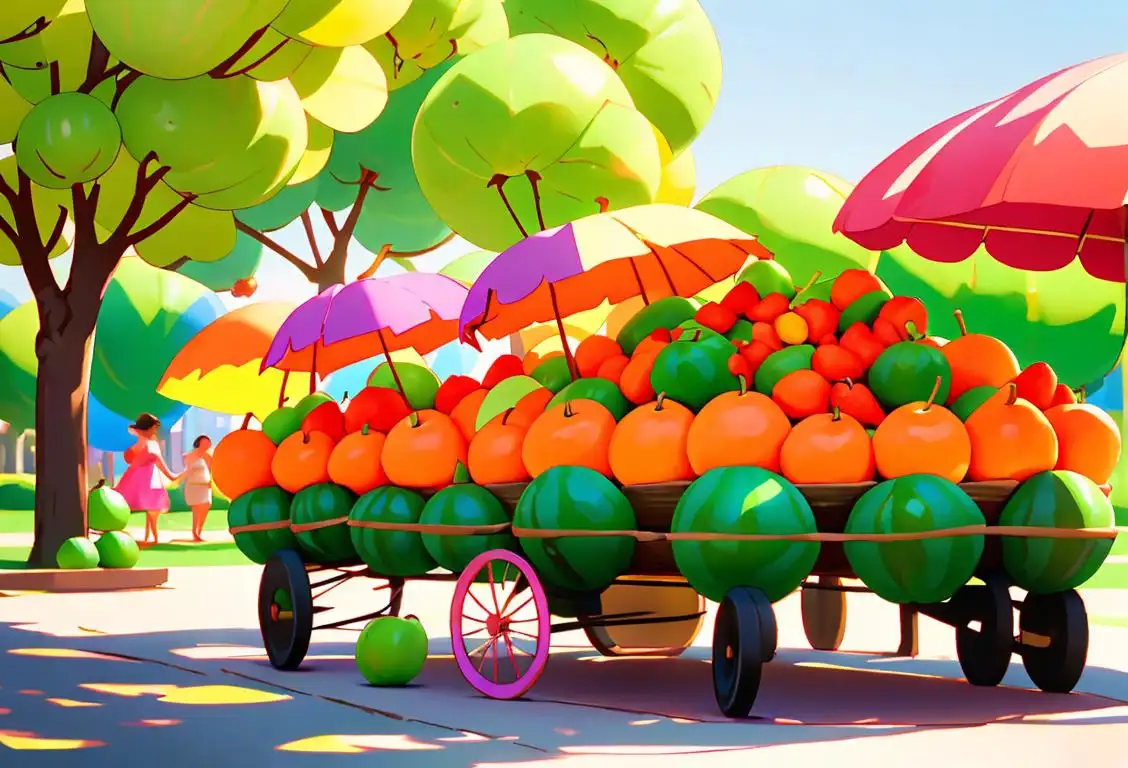National Melon Day

Welcome to National Melon Day, where we celebrate the juicy, refreshing wonders of this delightful fruit! Grab your cutest fruit-themed outfit and get ready for a celebration that will make even the juiciest watermelon blush. Whether you're a fan of watermelons, cantaloupes, honeydews, or any other melon variety, this is the day to show your melon love!
When is Melon Day?
It's national melon day on the 14th August.
The Internet History of National Melon Day
Let's dive into the internet archives to uncover the origins of National Melon Day. It all started on August 14, 2016, when social media erupted with melon-filled excitement. People couldn't stop sharing mouthwatering photos of melon slices, colorful fruit salads, and melon-inspired recipes.
As the hashtag #NationalMelonDay started trending on Twitter, melon enthusiasts united to spread the love for these delicious fruits. Memes and puns about melons flooded the internet, creating a delightful atmosphere and proving once again that the internet has a soft spot for fruity festivities.
Since then, each year on August 14th, National Melon Day is enjoyed by melon lovers around the world. From picnics in the park to melon-themed parties, people find creative ways to honor and enjoy these juicy treats.
How to Celebrate National Melon Day
Now that you know the delicious history of National Melon Day, it's time to plan your own melon extravaganza! Here are a few suggestions to fuel your melon-loving soul:
- Organize a melon carving competition with your friends and family. Get creative and see who can sculpt the most impressive melon masterpiece.
- Host a melon taste-testing party. Explore the wide variety of melons available and sample their unique flavors. Rate each melon and crown the ultimate melon champion.
- Create a refreshing melon beverage. Whether it's a watermelon slushie, a cantaloupe smoothie, or a honeydew cooler, let your taste buds tango with melon-infused bliss.
History behind the term 'Melon'
3000 BCE
Ancient Origins
Melons have a rich history dating back to around 3000 BCE. They were originally cultivated in Africa and gradually spread throughout the Mediterranean region and Asia. In ancient Egypt, melons were highly regarded and were often placed in the tombs of pharaohs to nourish them in the afterlife.
7000 BCE
Early Cultivation
Melons have a long history, dating back to around 7000 BCE when they were first cultivated in Africa and Asia. The wild ancestor of the melon, known as Cucumis melo, is believed to have originated in Africa. Early cultivators discovered the delicious and refreshing flavor of this fruit, leading to its cultivation and spread across other regions.
700 BCE
Greek Influence
The Greeks were enamored with melons and greatly contributed to their cultivation and breeding. They saw melons as a symbol of prosperity and abundance. Greek literature, including the works of poets like Homer and Hesiod, frequently mentioned melons, further enhancing their popularity.
2400 BCE
Mesopotamian Melons
Melons were highly regarded in ancient Mesopotamia and were even mentioned in ancient texts, such as the Epic of Gilgamesh. The people of Mesopotamia cultivated and enjoyed various types of melons, including watermelon, which were valued for their flavor and thirst-quenching properties.
400 BCE
Roman Indulgence
During the Roman Empire, melons became a coveted luxury. Roman cultivation techniques and agricultural advancements allowed for the production of more varieties of melons. The Romans even built specialized structures called 'melones' to provide shade for growing melon plants and protect them from harsh weather.
300-500 CE
Introduction to Europe
The cultivation of melons reached Europe during the period between the 3rd and 5th centuries CE. Melons were introduced to the region by the Romans, who brought them from their conquered territories in Africa and Asia. Their popularity quickly grew, and melons became a cherished fruit among the aristocracy in ancient Rome.
14th Century
Melons Reach Europe
Melons reached Europe during the 14th century through trade routes with the Islamic world. Their introduction to Europe brought a refreshing and exotic fruit to the continent. European countries such as Spain and Portugal embraced melons and began cultivating them in their own regions.
10th century
Asian Varieties
During the 10th century, Asian cultures began cultivating and developing their own unique varieties of melons. China, in particular, became renowned for its melon cultivation and created numerous hybrid varieties with distinct flavors, textures, and aromas. Some Chinese melon varieties were even presented as luxurious gifts to emperors.
16th Century
Melons in the New World
With the exploration and colonization of the Americas, melons eventually found their way to the New World. European settlers brought the seeds and cultivation knowledge, leading to the establishment of melon farms in various regions of North and South America.
15th century
Melons in the New World
With the Age of Exploration, melons found their way to the New World. Spanish explorers and settlers introduced melons to the Americas during the 15th century. The indigenous people quickly embraced the fruit, incorporating it into their diets and cultivating melons in various regions. Melons became an important part of the culinary traditions of the Americas.
19th Century
Modern Varieties and Cultivation
The 19th century witnessed significant advancements in melon cultivation and the development of various melon varieties. Farmers focused on improving melon flavor, size, and disease resistance. This era marked the transition from traditional landrace melons to selectively bred hybrids that became more widely available.
17th century
Watermelon in Colonial America
In the 17th century, watermelon gained popularity in colonial America. European settlers brought watermelon seeds with them, and the fruit thrived in the warm climate. Watermelon became a common crop, and its refreshing taste made it a favorite summer treat. It became synonymous with American picnics and celebrations.
18th century
Melon Varieties Flourish
The 18th century witnessed the diversification of melon varieties. Breeders began developing new cultivars with different sizes, shapes, and flavors. French, Spanish, and Italian horticulturalists played significant roles in the advancement of melon breeding, introducing melons with exquisite tastes and fragrances. This period marked a pivotal moment in melon cultivation.
Did you know?
Did you know that watermelons are considered both a fruit and a vegetable? Botanically, they're classified as a fruit because they develop from the fertilized ovary of a flower. However, they're often considered a vegetable in culinary terms due to their savory, versatile nature. Talk about melon dual citizenship!Tagged
food funFirst identified
14th August 2016Most mentioned on
14th August 2016Total mentions
12Other days
Bacon Day
Sweet Tea Day
Medal Of Honor Day
Iced Tea Day
Pumpkin Day
Guac Day
Vodka Day
Foundation Day
Cheese Pizza Day
Pina Colada Day









